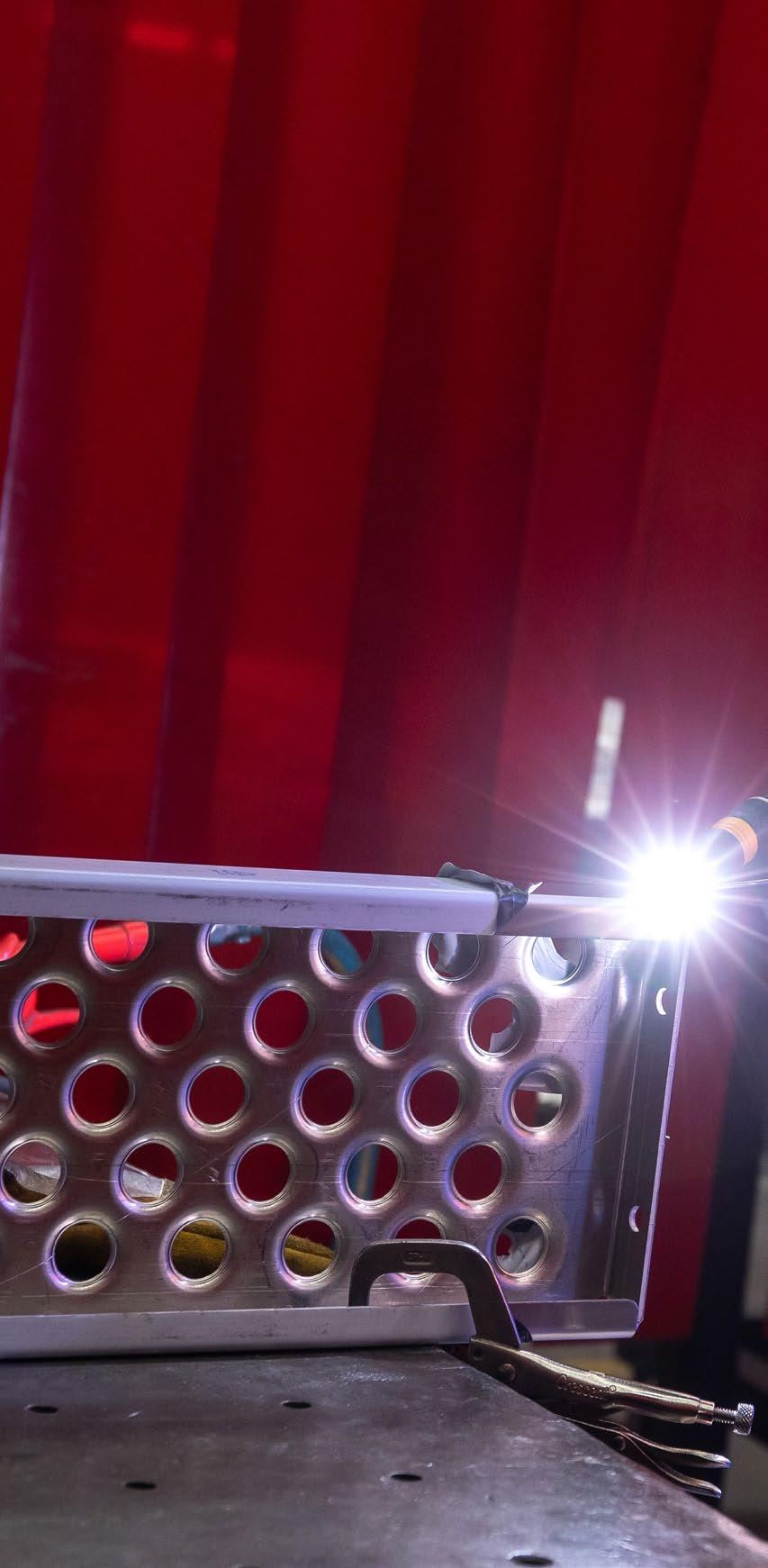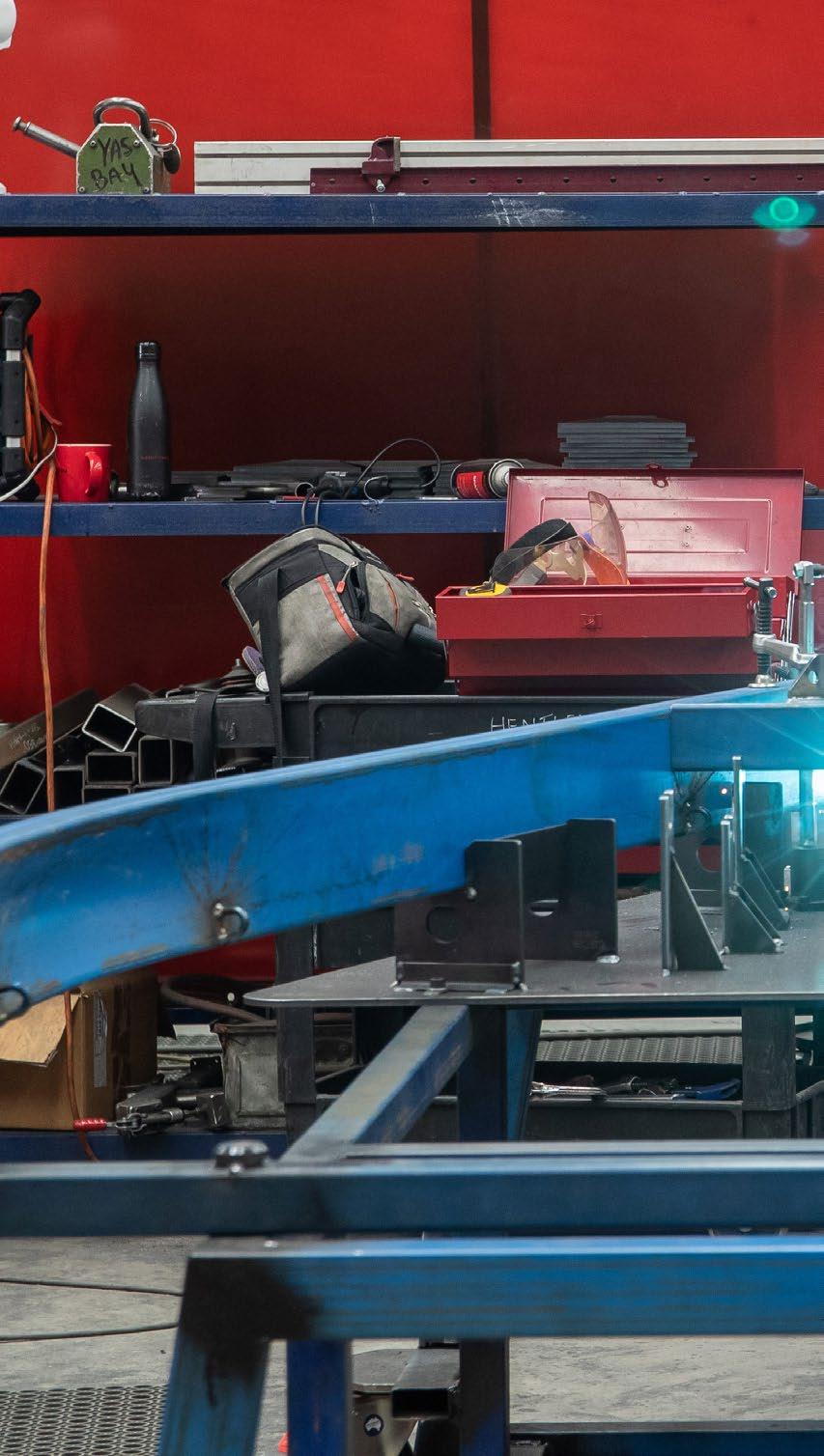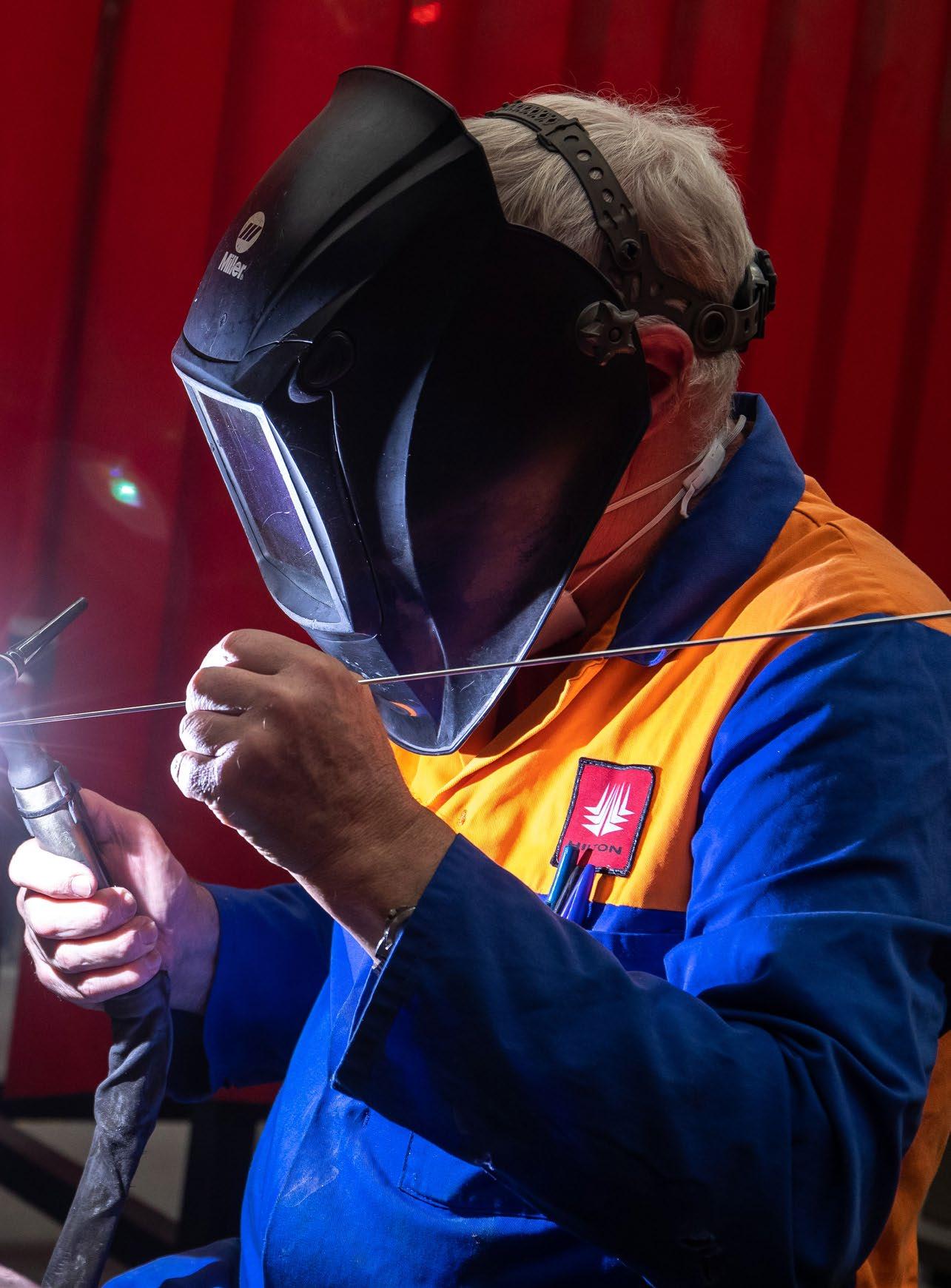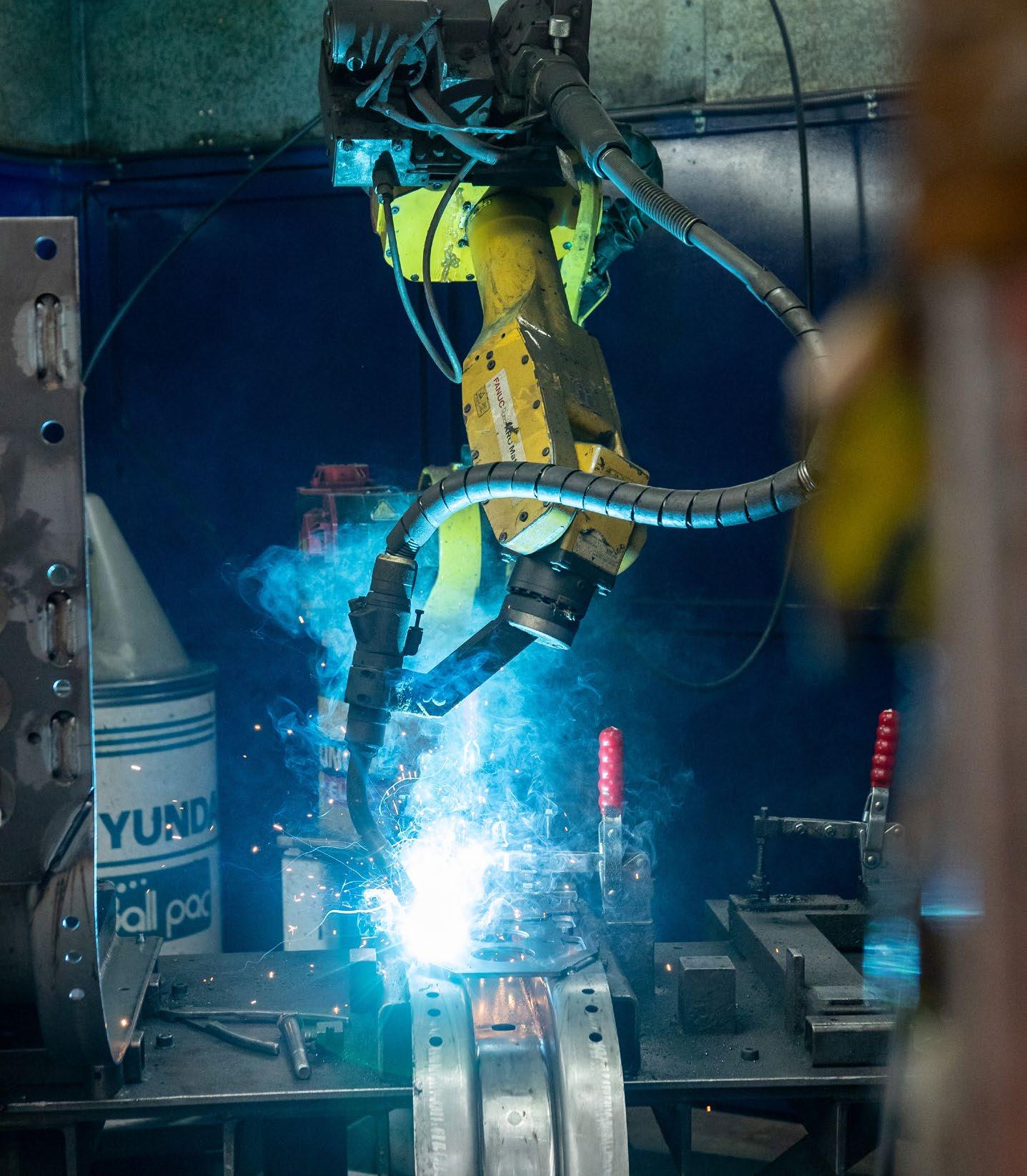
13 minute read
Cover: Hilton Manufacturing: Dynamic. Diversified. Progressive. Story on
HILTON: DYNAMIC. DIVERSIFIED. PROGRESSIVE.
Precision engineered sheet metal products since 1976
Advertisement
Established in Dandenong in 1976, Hilton Manufacturing provides a complete product service, from inception right through to completion. Hilton’s experience and expertise extends across all aspects of sheet metal manufacturing, including the rolling, forming, bending, pressing, folding, CNC routing, machining, welding and polishing of aluminium, mild steel and stainless steel. With a focus on quality control, lean manufacturing principles and robotics, Hilton is poised for even more success.
Since the company’s inception in 1976, Hilton Manufacturing has set the highest of standards in precision engineering and manufacturing quality, living by their values of Dynamic, Diversified and Progressive.
Husband and wife team, Margo and Tom Hartley, established Hilton Manufacturing in Dandenong, in Melbourne’s south-east. According to Todd Hartley (Managing Director, Hilton Manufacturing), “My mum and dad started the business in a little 300m2 shed in Hilton Street in Dandenong—that’s where the company name comes from.”
A tool maker by trade, Tom already had a diverse range of experience under his belt. He’d completed his apprenticeship at Repco in Richmond, and worked at International Harvester and a couple of other sheet metal businesses.
“Tom had just been retrenched from another sheet metal company, and he thought ‘bugger this, I’ll go and start up my own business’. And so that’s how Hilton started. Our first workshop was across the road from International Harvester—they soon became our first client. From there, the company just grew. We stayed in Hilton Street for about five years, before moving into a larger premises to better service our growing client base,” said Todd.
“In the late 1980s when the recession hit, we were purely a truck component manufacturer. We realised that we couldn’t just rely on one industry. So, we looked at expected market trends for the next 20 to 30 years. Baby Boomers would be retiring and either buying a caravan and travelling across the country, or going into a nursing home. So, we approached a caravan assembler and became their preferred supplier for sheet metal, and followed a similar scenario for manufacturing hospital beds.”
Photos: Hilton’s main 20,000m2 headquarters and manufacturing plant in Dandenong, Melbourne.



“Our key was to diversify outside the trucking industry, which helped fast track our growth. We had a business plan in place that emphasised measured growth, and we marketed our capabilities in trucking—rather than the industry itself—to bring other industries onboard,” said Todd.
Hilton Manufacturing remains a family owned and run business, and now operates from two modern manufacturing facilities. Their main 20,000m2 headquarters and manufacturing plant is still in Dandenong, while their 6,000m2 northern manufacturing is located in south-west Brisbane.
“Even with our significant growth and expansion, Hilton continues to be based in Dandenong. We think this is important. We see Dandenong as the largest manufacturing hub in the country. Not only is there a significant number of OEMs in the area, there is also an extensive supplier network, which is very convenient,” said Todd.
Hilton services the needs of clients across a range of diverse industries including transportation (truck, bus, rail and leisure), defence, civil, commercial, agricultural and health care.
Hilton is proud of its working associations with some of the world’s great vehicle brands, including Kenworth, Volvo & Mack, Daimler-Chrysler, Volgren New Age Caravans and Rheinmetall Defence. These manufacturers recognise and rely on Hilton to produce the highest quality sheet metal products and associated componentry, as well as original equipment.
Hilton’s product experience and quality has also led to providing products beyond the local Australian market into export markets for brands like Tata Daewoo in Korea; Hino, Nissan UD and Isuzu in Japan; Westport in Canada; and Scania in Sweden.
“We see ourselves as one of the largest subcontractor sheet metal manufacturers in the country. We work with aluminium, stainless steel and mild steel, up to 16mm in gauge. We currently employ over 300 staff, and have a workshop with 80 pieces of CNC equipment. We’ve also invested heavily in automation over many years, and are having our 19th welding robot commissioned at the moment,” said Todd.
“We can make just about anything—no job is too complicated. Our business is very diverse, which allows us to be a preferred supplied not only for the truck industry, but for healthcare, caravans, bus, traffic management and defence. We’re even investigating opportunities in the power generation industry at the moment, which we think will be a
major growth industry for many years to come.”
The Secret to Hilton’s Success When asked what their secret to success has been over the last 45 years, Todd had a straightforward answer.
“We’ve always had a philosophy of measured growth. We don’t like peaks and troughs. We maintain measured growth through efficiencies in the workshops, and investments in equipment and automation,” said Todd.
Hilton has heavily invested in its people, processes and plant to ensure the company remains highly competitive in a global economy. Many of their more repetitive highvolume processes are undertaken by robotics, to ensure cost effectiveness and consistency of outcomes. Despite this, Hilton is still very much a ‘people operation’ that supports its growing team. Hilton really only looks to robots where production volumes, capacity or safety dictate the necessity.
A lean manufacturing culture is also ingrained in Hilton’s DNA to ensure the company’s ongoing global competitiveness. Their processes encompass Lean Capability, 5S and Just in Time methodologies.
“We follow lean principles in our manufacturing, and try to simplify our processes wherever possible. We are continually reviewing our shopfloor layout for further efficiency. We currently manufacture over two million parts per annum so it is critical that we don’t over complicate things on the shop floor. Most of our efficiencies come from embracing lean principles, which make all our products highly price competitive,” said Todd.
Quality control and assurance has also played a key role in Hilton’s success over the years. Hilton is accredited to internationally recognised standards ISO 9001 Quality management, ISO 14001 Environmental management systems and AS/NZS ISO 3834.2 Quality requirements for fusion welding of metallic materials.


“We worked closely with Weld Australia to become certified to AS/NZS ISO 3834 in 2020. At the moment, we’re working with Weld Australia again on certification to DIN 2303 Welding and allied processes - Quality requirements to be met by production and maintenance companies for military products. Once this is complete, we will also investigate certification to EN 15085 Railway applications - Welding of railway vehicles and components,” said Todd.
Environmental sustainability has also played a role. Hilton minimised their environmental footprint by investing in a Sun Tracking Solar Farm at their Melbourne facility. This now delivers 200 Kilowatts of capacity. Hilton also implemented variable speed drive compressors and power factor correction units at their facilities, which ensure minimal spikes in their power consumption. The Future of Hilton Todd has his sights set firmly on the future. “We need to maintain our competitiveness, and keep investing in our facility and people. We have to continue to evaluate our waste, purchase more sustainably, and focus on growing industries like the electric vehicle market. We also need to continue investing in existing markets and products like our bullbars and bumper bars,” said Todd.
“I think there are enormous opportunities in the Australian welding industry at the moment. When the automotive industry closed down, manufacturing seemed to have been forgotten about. But, in the wake of the COVID-19 pandemic, it seems that the politicians are supporting the onshoring of manufacturing work.”
“The problem is, unless the local manufacturing industry has the staff and the capacity to undertake the work, it’s pointless. At the moment, the local manufacturing industry is at complete capacity—we just don’t have the capacity to manufacture the work that’s coming back into the country,” said Todd.

“Due to this looming shortage of welders, a number of years ago we initiated our own welding school at Hilton. We joined forces with Chisholm Institute, and had good success. The course features a modular way of training welders, with them working in our facilities for blocks of four to eight weeks.”
“SEMMA has taken the course onboard and supported enrollments, so that the course benefits the entire local region. The course could be rolled out across the state or even the entire country. We’ve been telling the government for many years now that the industry is thousands of welders short. Hopefully one day, the government will do something about the skills shortage and support the industry in finding and training the thousands of welders needed.”

“For a country like Australia to prosper, you need a strong manufacturing industry, manned by skilled workers,” said Todd.
Further Information For further information about Hilton Manufacturing and their services, visit: hiltonmanufacturing.com.au
THE MOVE TO AUTOMATION TO IMPROVE PIPE FABRICATION
BY SOROUSH KARIMZADEH (CEO, NOVARC TECHNOLOGIES)
There is currently an acute shortage of skilled welders required to meet the demand for pipe welding needed to construct the world’s essential infrastructure: the construction of data centres, ships, hospitals, LNG plants and more. This workforce shortage combined with supply-chain management difficulties caused by the COVID-19 pandemic, has resulted in a significant challenge for the industry. Escalating costs and delays in scheduling have also created massive bottlenecks in the construction of industrial plants necessary to meet the needs of developed and developing economies world-wide.

To complicate this extremely challenging situation, pipe shops serving global industries such as oil and gas, energy utilities, water and wastewater, shipbuilding, chemical and nuclear plant construction and maintenance require highly skilled welders.
It is predicted there will be a shortage of nearly 30,000 welding operators in Australia by 2025. With an ageing welder workforce and a lack of uptake of the welder trade, there are no simple solutions to this welder demographic.
Why Welding + Technology Makes Sense Novarc launched the world’s first welding cobot to minimise and help eliminate this bottleneck in construction by enabling welders to be significantly more productive and efficient. Novarc’s collaborative Spool Welding Robot (SWR) was launched in 2016.
With Novarc’s SWR, pipe fabrication shops can realise significant gains in productivity, weld quality, payback and support, typically seeing a 3-5x productivity increase in carbon steel welding, and a 12x increase in productivity in stainless steel welding. On the shop floor, introducing welding automation technology helps junior welders take on challenging welds which previously could only be performed by senior welders, while senior welders can then broaden and extend their careers.
Collaborative Welding With Novarc’s SWR, the collaborative robot works with the operator, who does not need to learn a special programming language or have multiple years of robotic experience. The cobot can be positioned anywhere in the shop, and only requires a 1.2m x 1.2m footprint, as the built-in safety system effectively eliminates the need for fencing. The cobot can integrate with two to five positioners for maximum arc-on time, and is fast and remarkably easy to set up, averaging two to three minutes between joints. The SWR cobot is capable of welding stringers and multipass joints to produce codequality groove and fillet welds.
The cobot enables non-stop root-tocap welding, with no need to shut off the arc between weld passes. The welder can use built-in features such as Tack Fusion™, Root Save™ and Repeat Pass™ to accommodate tack welds and variable joint fit-ups. These features were specifically developed with Welding Operators in mind, to address the typical “everyday variability” associated with pipe welding and fabrication.
According to Cyrus Patel (Piping Superintendent, Western Allied Mechanical), Novarc’s Spool Welding Robot is expanding their project capacity. “We’re now going after projects that we were shying away from because of the size. Since we have implemented the SWR, we have been spooling a lot more and we are also taking on bigger projects, knowing that we have the capabilities of the welding in place. So it’s actually helped us go after some projects that we were not going after before.”
What Semi-Autonomy Enables The SWR cobot uses a laser scanner for tracking pipes that are 101.6mm (4”) in diameter and larger that enables semi-automated seam tracking with 0.3mm accuracy. In addition, the SWR also maintains: • Automatic stick-out distance control (tip to pipe distance) with 0.1mm accuracy • Automatic positioner switch assembly (APSA) switching the welding cable and voltage sensing lead between multiple positioners based on operator’s selection of positioner

Photos Left: Novarc’s cobot helps junior welders perform more-challenging welds previously only performed by senior welders while also allowing senior welders to broaden and extend their careers.. Below (Left): The cobot enables non-stop welding from the root pass to the final weld layer with no need to shut off the arc between weld passes Below (Right): The pre-programed procedures ensures that the SWR deliverables repeatable and reliable stainless steel pipe, fitting and flange welds.
Increase in Stainless Steel Pipe Welding Productivity = Increase in ROI Using the collaborative SWR, pipe shops can increase their stainless steel pipe welding productivity by up to 12x, and see a 3-5x improvement in carbon steel pipe welding productivity, with a typical return on investment between six to 18 months. All while ensuring weld quality is maintained or improved.
“We were shocked to see that there was a three times increase in productivity using the SWR,” said Peter Tuck (Regional Vice President, Black & McDonald). “But we’re also very pleased at the high level of safety it provides our workers.” Typically, welders are producing 200-350 diameter inches per shift on carbon steel pipes, and 569998 diameter inches per shift on stainless steel pipes with the SWR. Welders find it easy to scale up quickly, working with an easy-touse Human-Machine Interface (HMI) which enables the welder to select the pre-programed welding procedure, and easily tune the weld and motion parameters. Using this automation technology on stainless and carbon steel pipes helps welders achieve defect rates lower than 1%, compared to the North American average of 3% to 5% for semi-automatic welding. As well, the welding system meets the requirements of ASME Section IX, B31.1 and B31.3, and key quality test requirements such as radiographic examination, charpy impact tests, hardness tests, bend tests and tensile tests.

This has significant practical benefits for many mechanical contractors working in pipe fabrication. According to David Ray (Fabrication Shop Foreman, W.W. GAY Mechanical), the decrease in time to weld pipes using automation technology is a game changer. “Our old way of welding stainless steel would be to TIG weld using an ID purge. A 16” schedule 10 weld would take 2 ½ hours or so to get a purge set up and the weld out. We now can do a 16” schedule 10 weld in 12 minutes that will pass RT.”
Novarc’s welding automation technology has revolutionised the manufacturing processes and is a productivity game changer for pipe fabrication shops serving the shipbuilding, building construction, oil and gas, and offshore industries.
Further Information For further information, visit: novarctech.com










